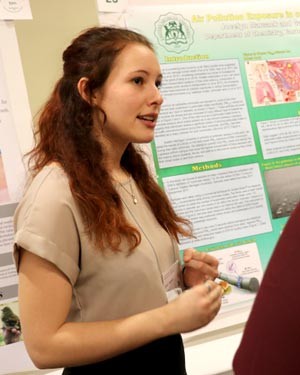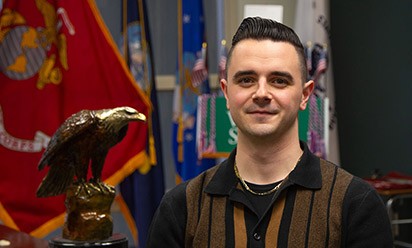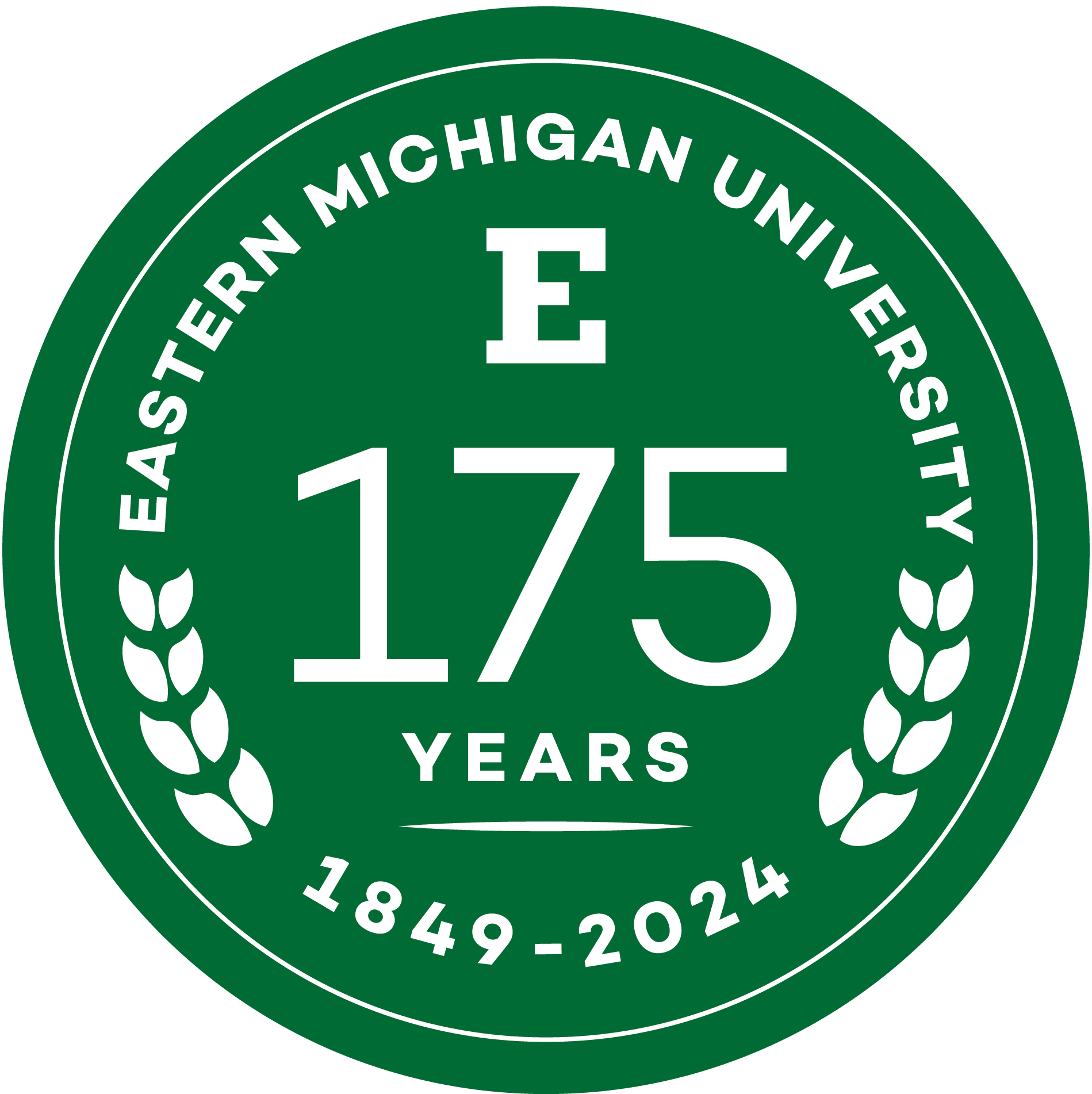From I-94 to Mars, and staying in school: The 38th annual Undergraduate Symposium featured innovative research on a wide range of topics

YPSILANTI – How can future civilizations on Mars extract underground water to sustain future civilizations? Which roads expose commuters to above average levels of air pollution? And how can educators address the school-to-prison pipeline?
These were just a few of the questions tackled by undergraduate researchers at the 2018 Undergraduate Symposium.
This symposium—the highlight of Eastern Michigan University’s academic year—took place on March 23 from 9 a.m. to 4 p.m. in the Student Center.
A sample of the more than 400 projects presented includes:
Humans – Solar Systems Species
A group of physics students presented their design for a drill to extract underground ice on Mars, and they will present their project to NASA during a video conference in the following weeks.
The drill uses a multi-step extraction process. The process starts by drilling into the ground and inserting the extractor. Then heated pipes turn ice into water vapor, the water vapor is converted back into ice, and rovers can then transport the ice.
While designing the drill, the researchers looked to plants and animals for inspiration.
The probe of a wood-wasp inspired the shape of the ground-penetrating drill tip, and the drill is built to expand like the body of a worm and enlarge the opening in the ground.
This process is intended to help future civilizations extract water on Mars for human consumption, and for fuel, agriculture, and other necessities.
In the upcoming weeks, the students will develop a prototype and present their final product to NASA as part of NASA’s University Student Design Challenge.
The students who researched this topic are Andrew Richardson, Larry Borum, Sam Carano, Rosalie Tezak, Ryan Walker and Kyle Wilhelm. Their faculty mentor, Dave Pawlowski, provided guidance and support throughout the project.
The students said that participating in the Undergraduate Symposium helped them refine their research and communication skills and address problems in their field.
“This project has given us an opportunity to work on a real-world problem, and it gives us a glimpse into what some of us physicists might be working on some day,” Richardson said.
Commuter Exposure to Air Pollution Traveling from EMU’s Campus

Student Jocelyn Marsack measured the levels of air pollution on nearby major roadways and researched how it could affect commuters’ health.
Marsack collected air samples with an AirQuality Node sampler, which measures particulate matter and carbon dioxide concentrations in the air.
She found that I-94, I-96, I-275, Route 23, and M-24 expose travelers to above average levels of air pollution. M-153 (Ford Road) and M-14 did not show significant levels of pollution, likely because they pass through rural areas.
Commuters who travel these routes potentially face long-term effects such as increased respiratory problems. There are no known short-term effects other than difficulty breathing for people with existing respiratory issues such as COPD, asthma, and emphysema.
Luckily, all of these roads scored relatively low concentrations of pollutants, according to the EPA Air Quality Index.
Marsack says this was her first research project.
“As my first research project, it really showed me the hard work necessary for quality research design and disseminating results of that work to a wide audience, especially at the Undergraduate Symposium,” said Marsack. “Participating at the symposium has ultimately made me a better student, future scientist and researcher.”
Interrupting the School-to-Prison Pipeline
Social work students Alyssia Hence, Taylor Parker, Breyanna Sylvia-Moals, and Gayle Springer researched causes and effects of the school-to-prison pipeline, as well as possible solutions.
Common education policies in the United States contribute to the overwhelming number of students who are funneled from public schools into the juvenile and criminal justice systems. This trend is known as the school-to-prison pipeline.
The school-to-prison pipeline is caused by many factors, such as zero-tolerance policies, police presence in schools, failing education systems, inadequate resources and the criminalization of youth behavior.
These factors often lead to suspension and expulsion, which exclude students from the school environment. At home, they are not learning from their mistakes and are missing out on their education. This further contributes to the academic and discipline gap in schools, the student researchers concluded.
The school-to-prison pipeline disproportionately affects students of color, LGBTQ+ students, and students with disabilities.
The researchers recommend that schools only use suspension and expulsion as last resorts. Instead, they believe conflict management should focus on more proactive approaches, such as restorative practices and evidence-based behavioral interventions and support.
The students who researched this topic are also completing internship requirements through a program called the Making Youth Matter Mentoring Program, which is a collaborative partnership between EMU’s School of Social Work and Ypsilanti Community Schools. The overarching goal of the program is to interrupt the school-to-prison pipeline.
As mentors, they offer social, emotional, and academic support. They also engage students in activities in the community such as museums, the movies, EMU’s campus and trips to places like Skyzone Trampoline Park.
“We’ve seen a lot of improvement in the kids,” said Sylvia Moals. “There’s so much going on in their lives that we can’t even imagine, and this gives them a voice.”
The internship with the Making Youth Matter program allowed the student researchers to directly engage with their research problem.
“This project is significant for me because I’m seeing it firsthand, establishing relationships, and helping interrupt the school-to-prison pipeline,” said Springer. “It’s great to know that what I’m doing is making a difference.”
The student researchers received support from their faculty mentors, Celeste Hawkins and Sarah Van Zoeren.
“Mentorship can truly make the different between a student who knows their limits or one who exceeds their expectations of their potential,” said Hence.
Presenting at the Undergraduate Symposium provided students with valuable research experience that they hope will help them in the future.
“This project has encouraged me as a student because I would have never thought that I would be a part of an experience like this,” said Sylvia-Moals. “It has motivated me to want to participate in more academic presentations.”
About Eastern Michigan University
Founded in 1849, Eastern is the second oldest university in Michigan. It currently serves more than 20,000 students pursuing undergraduate, graduate, specialist, doctoral and certificate degrees in the arts, sciences and professions. In all, more than 300 majors, minors and concentrations are delivered through the University's Colleges of Arts and Sciences; Business; Education; Health and Human Services; Technology, and its graduate school. EMU is regularly recognized by national publications for its excellence, diversity, and commitment to applied education. For more information about Eastern Michigan University, visit the University's website.
More Stories

Eastern Michigan University awards Summer Research and Creative Activity Grants.

Eastern Michigan University to launch new Bachelor of Business Administration in Financial Planning and Wealth Management degree.

Eastern Michigan University empowers student-faculty collaboration with Undergraduate Symposium Research Fellow Awards.

Eastern Michigan University senior Raya Lasiewski inspires hope and healing through personal journey with eating disorder.

Veteran exceeds limits to becoming an Eastern Michigan University graduate.

